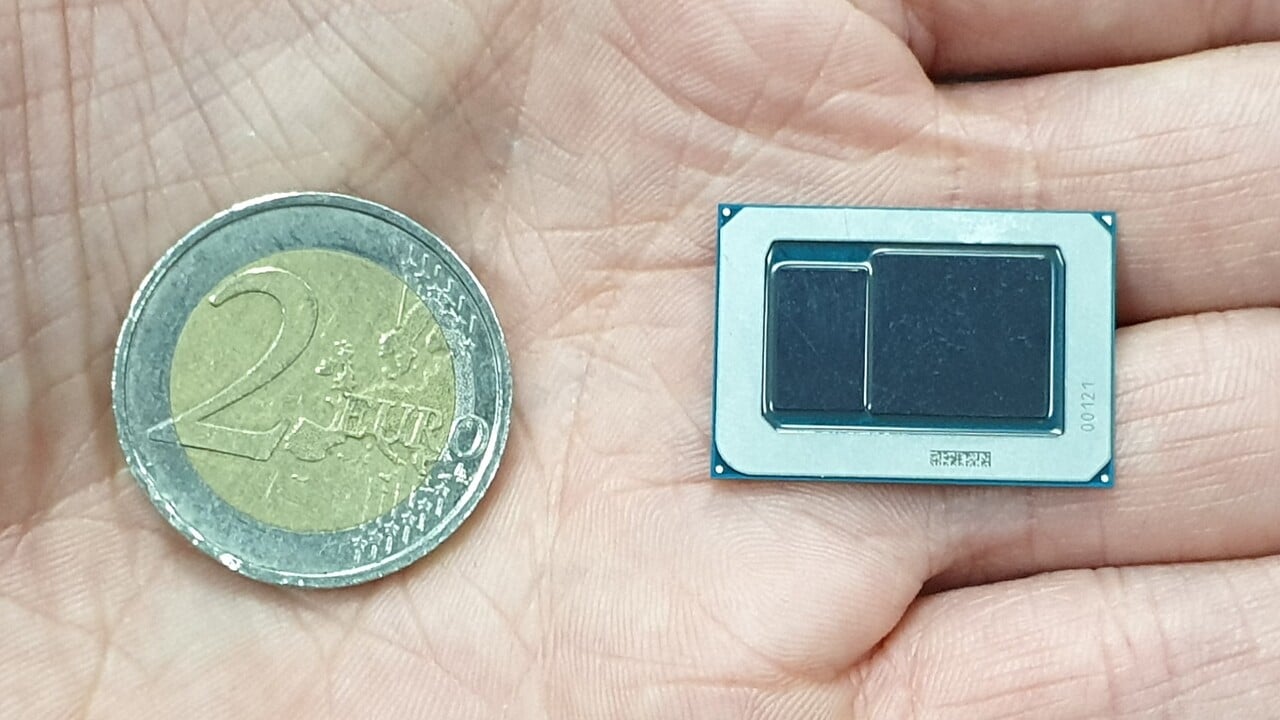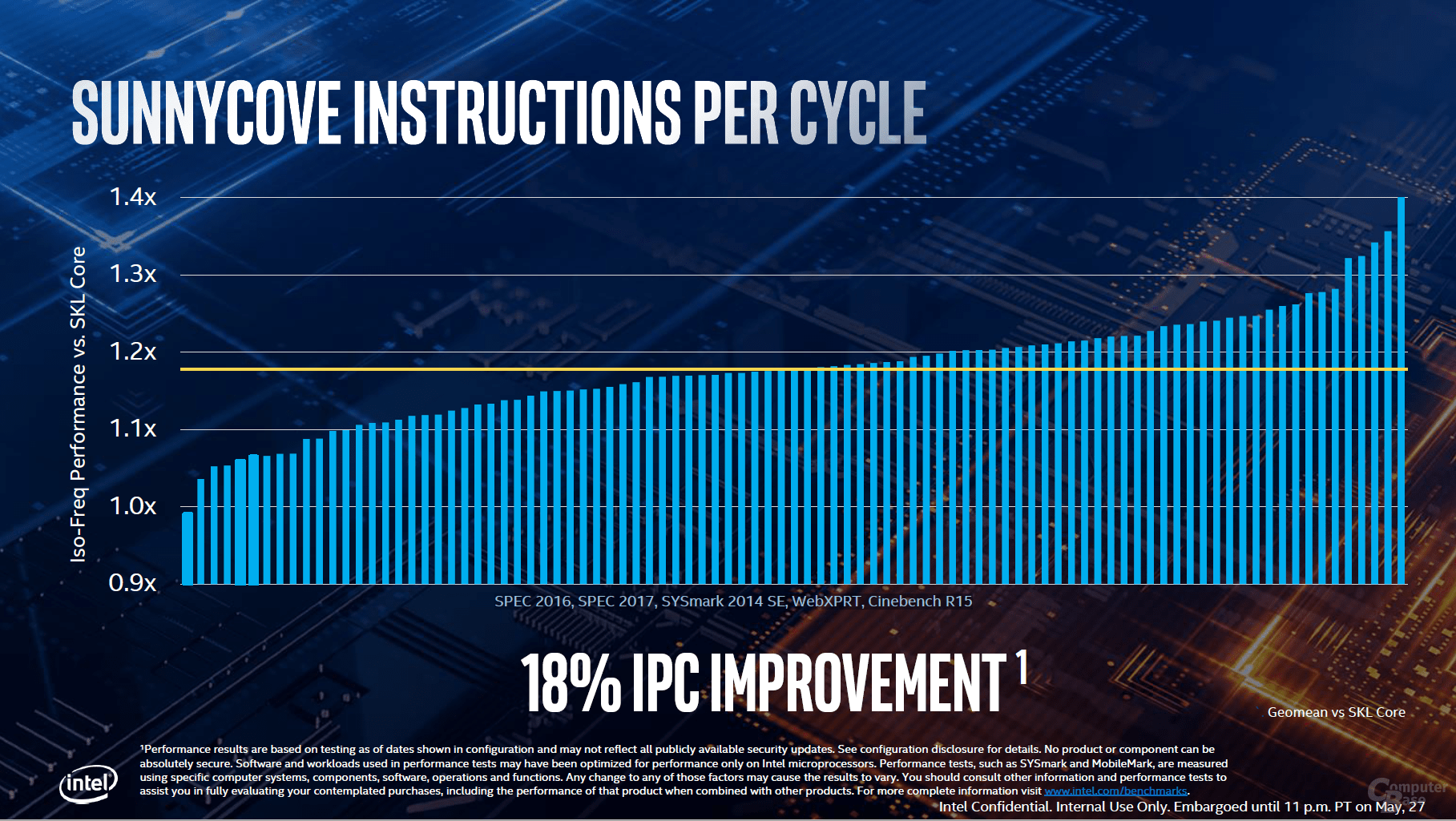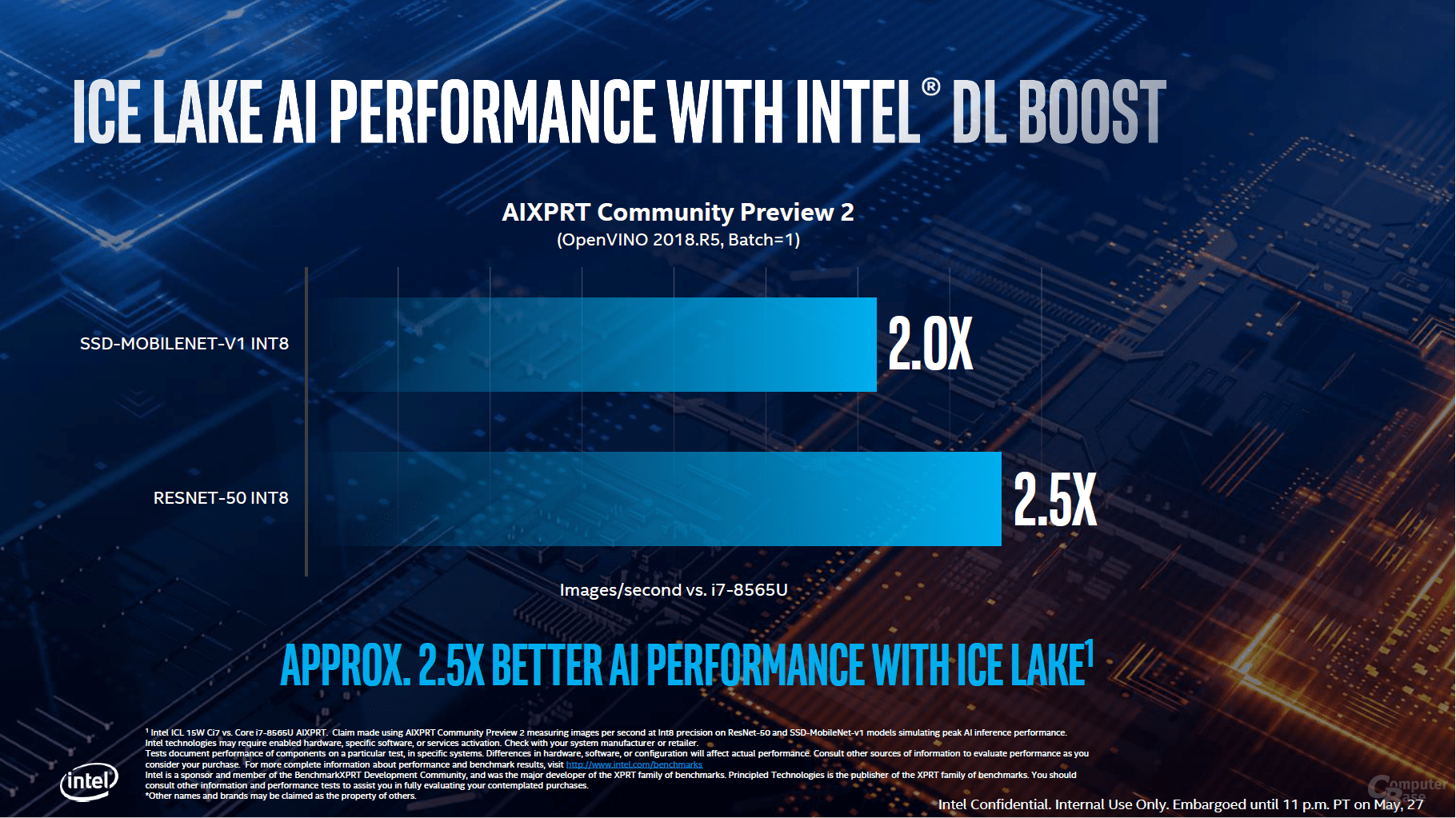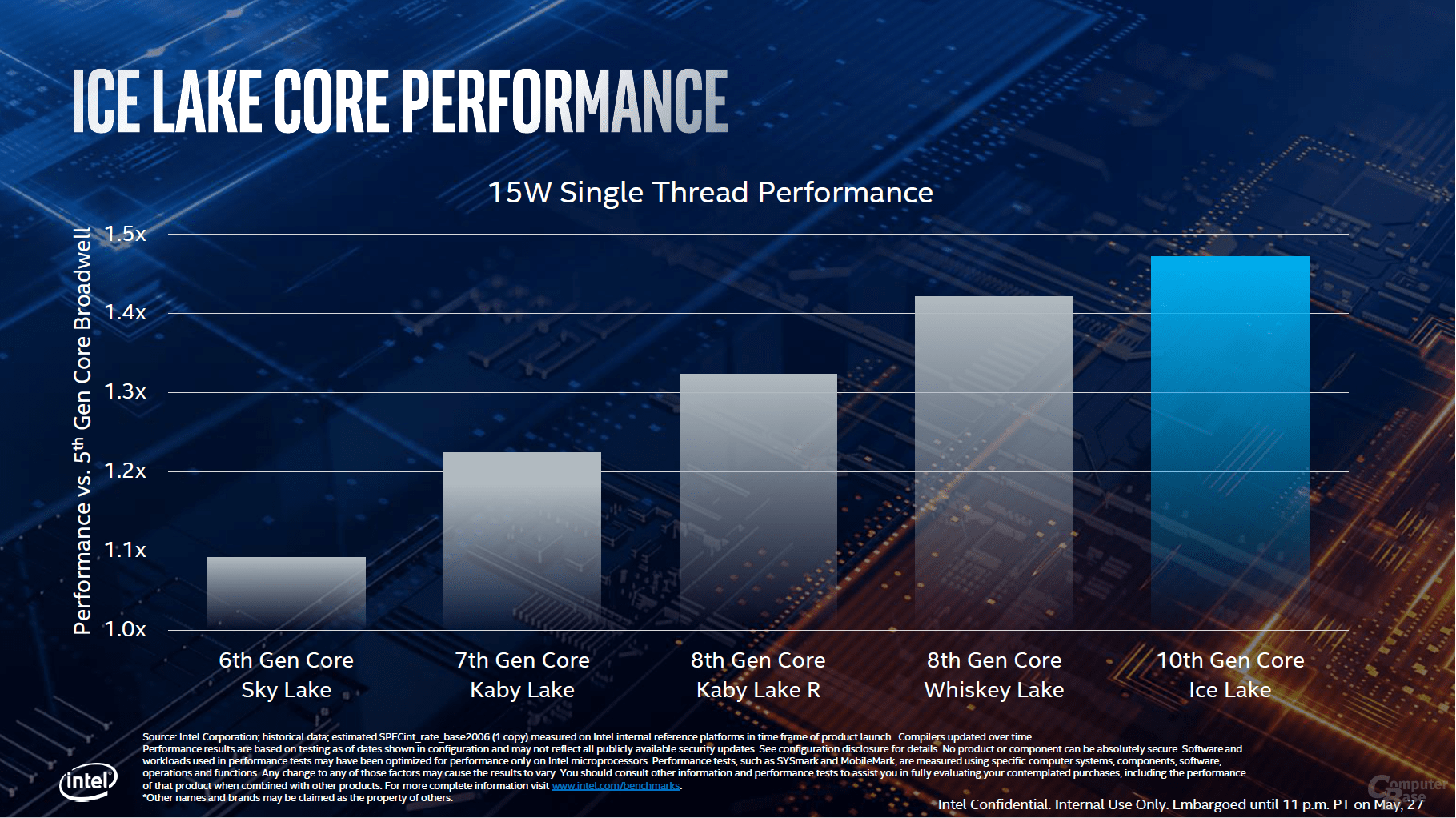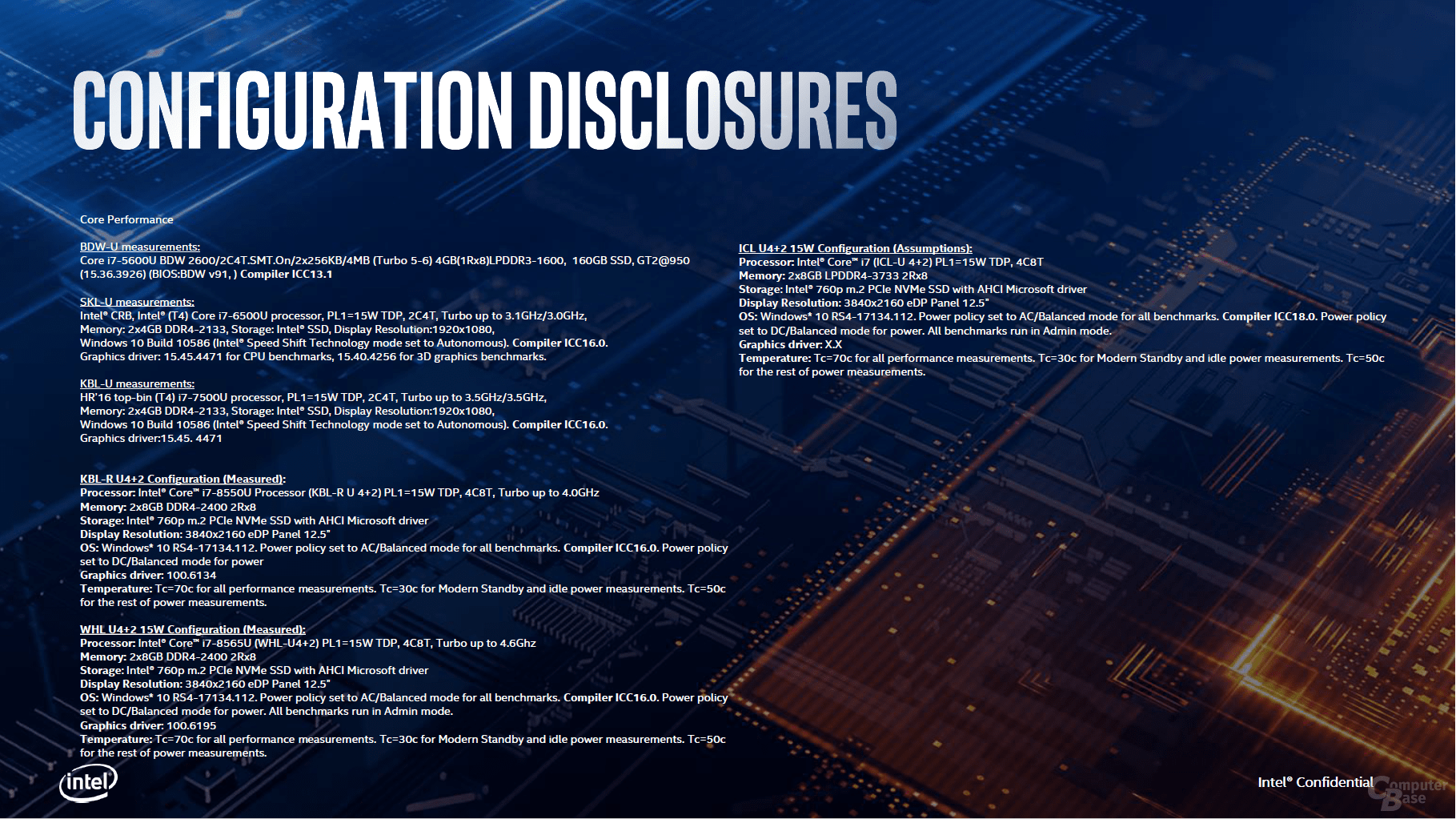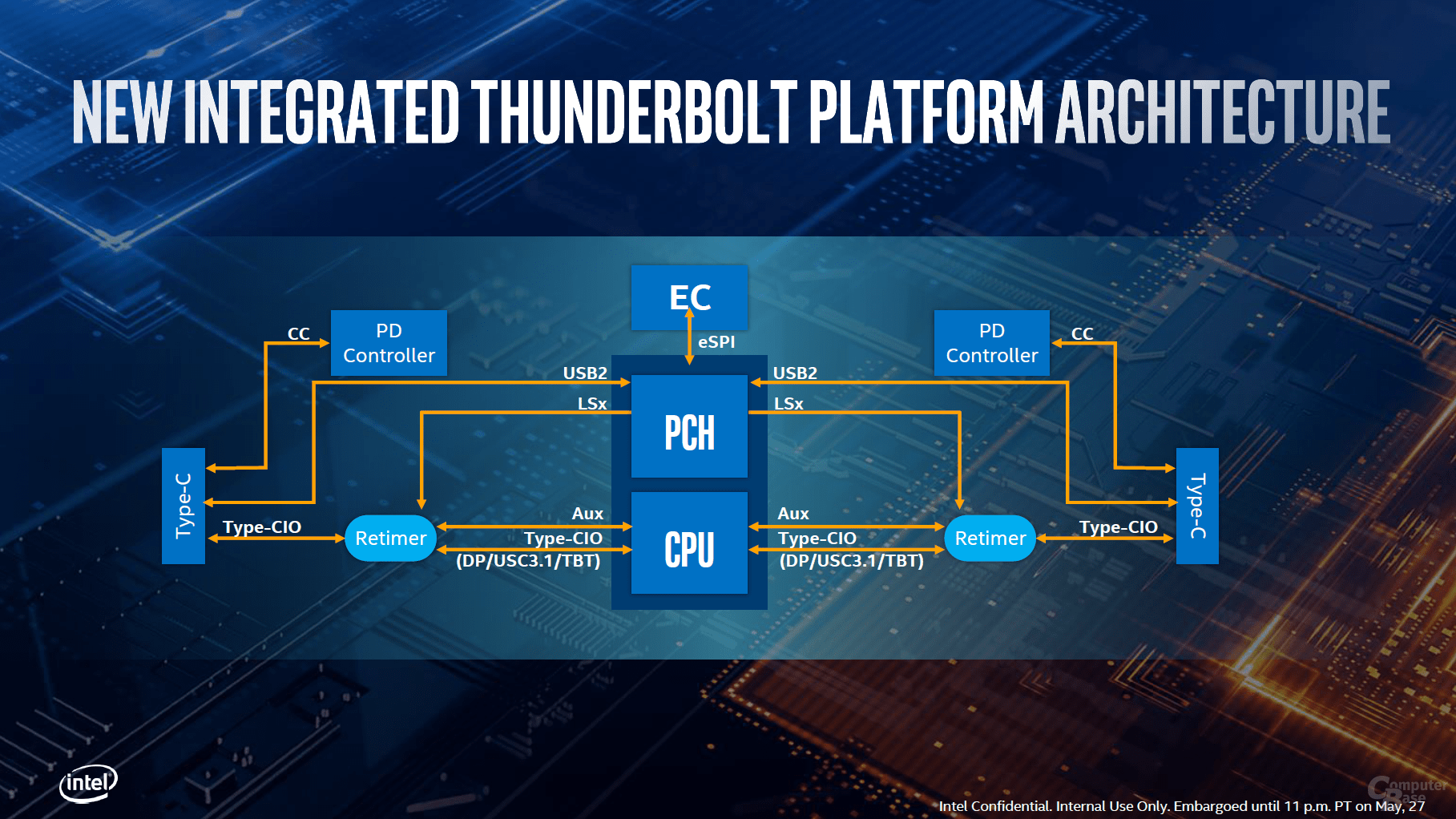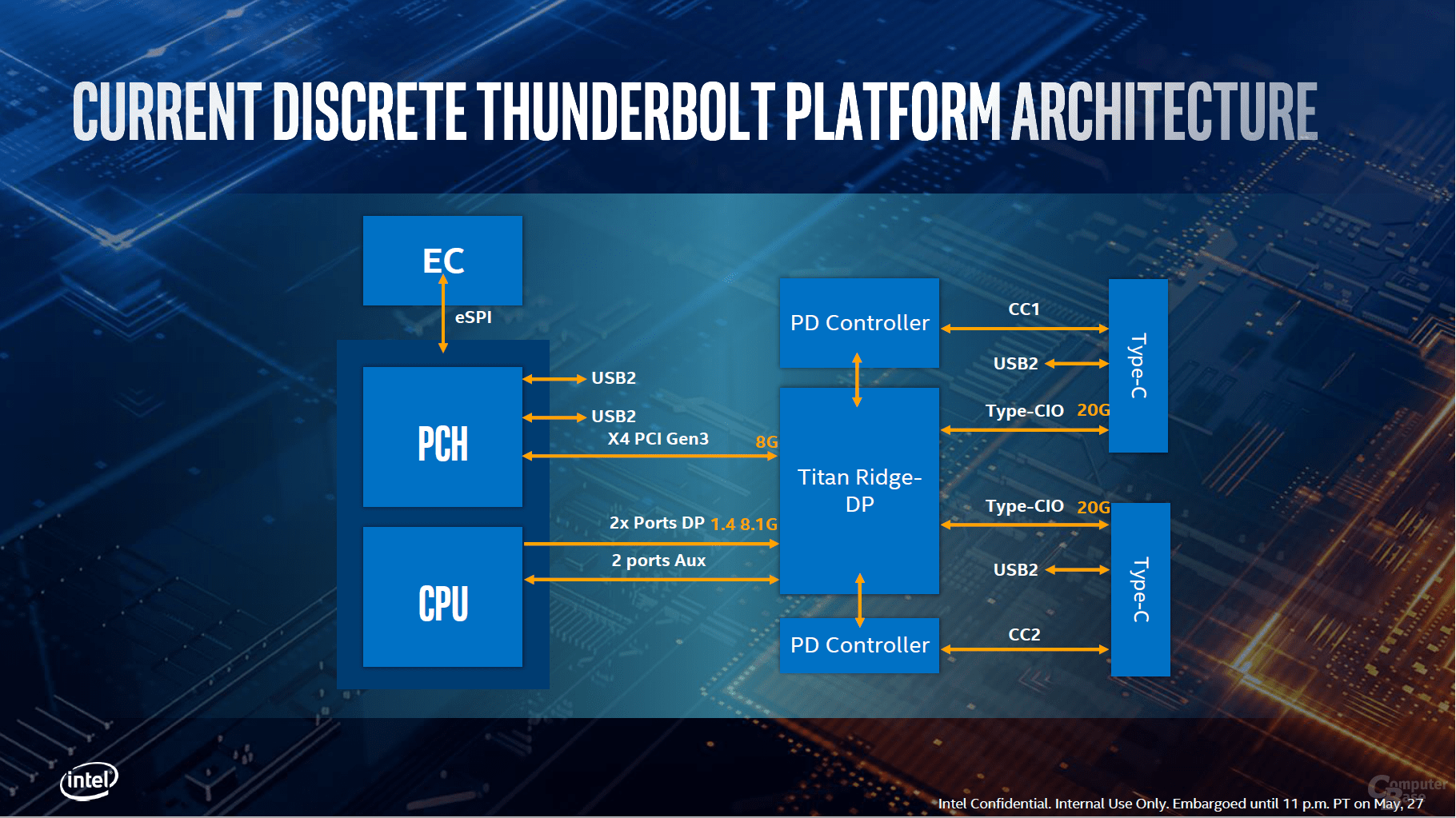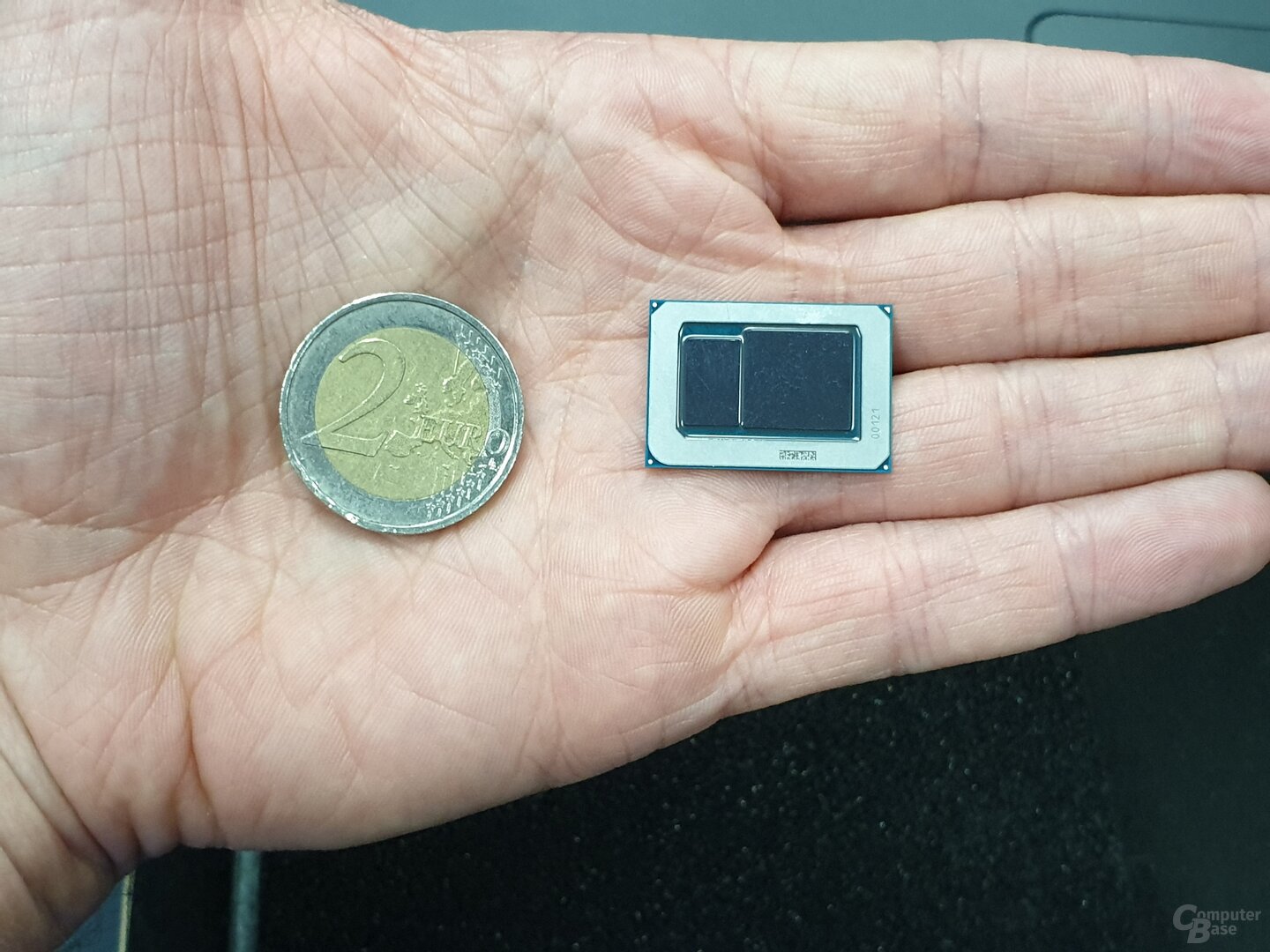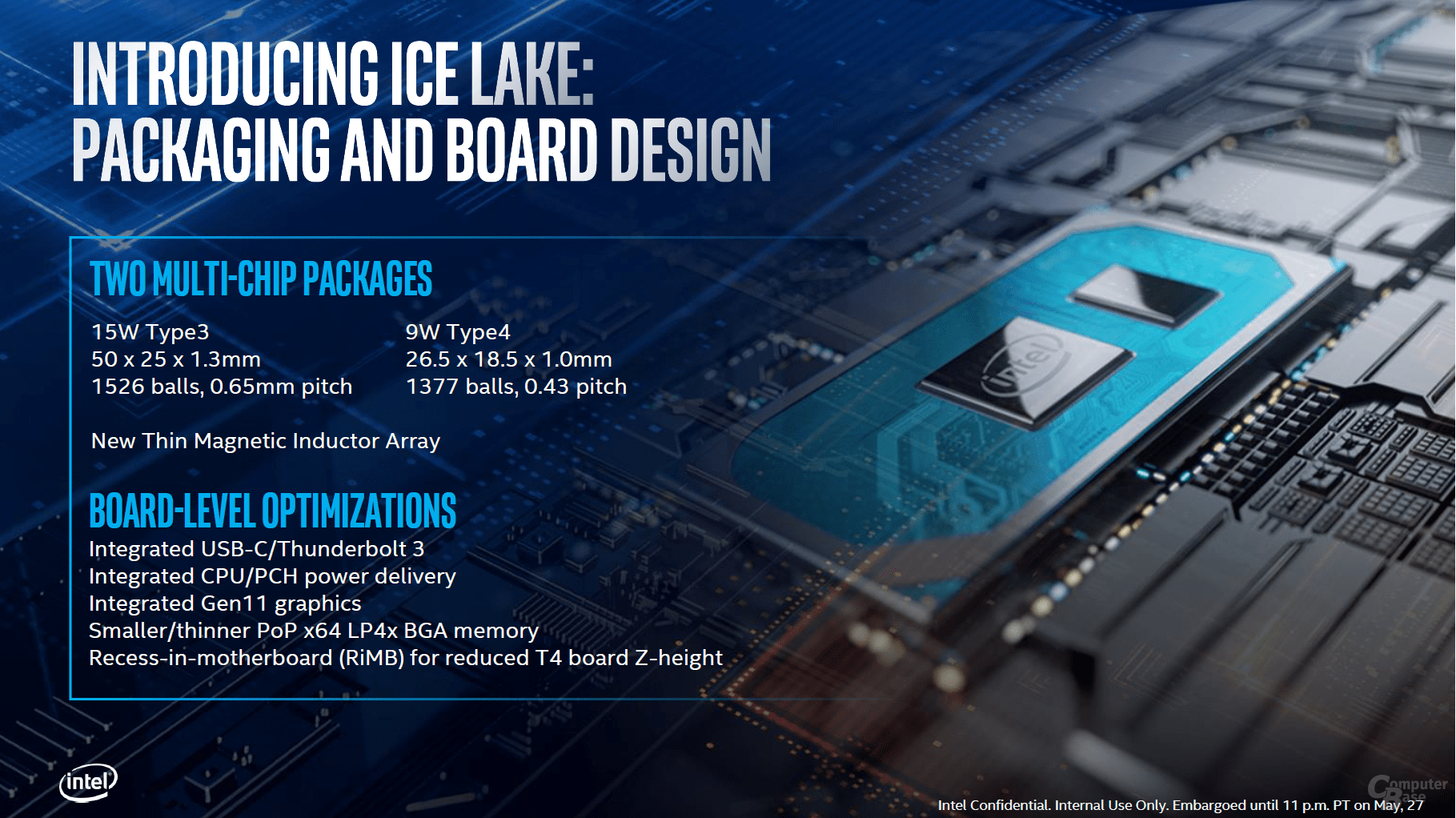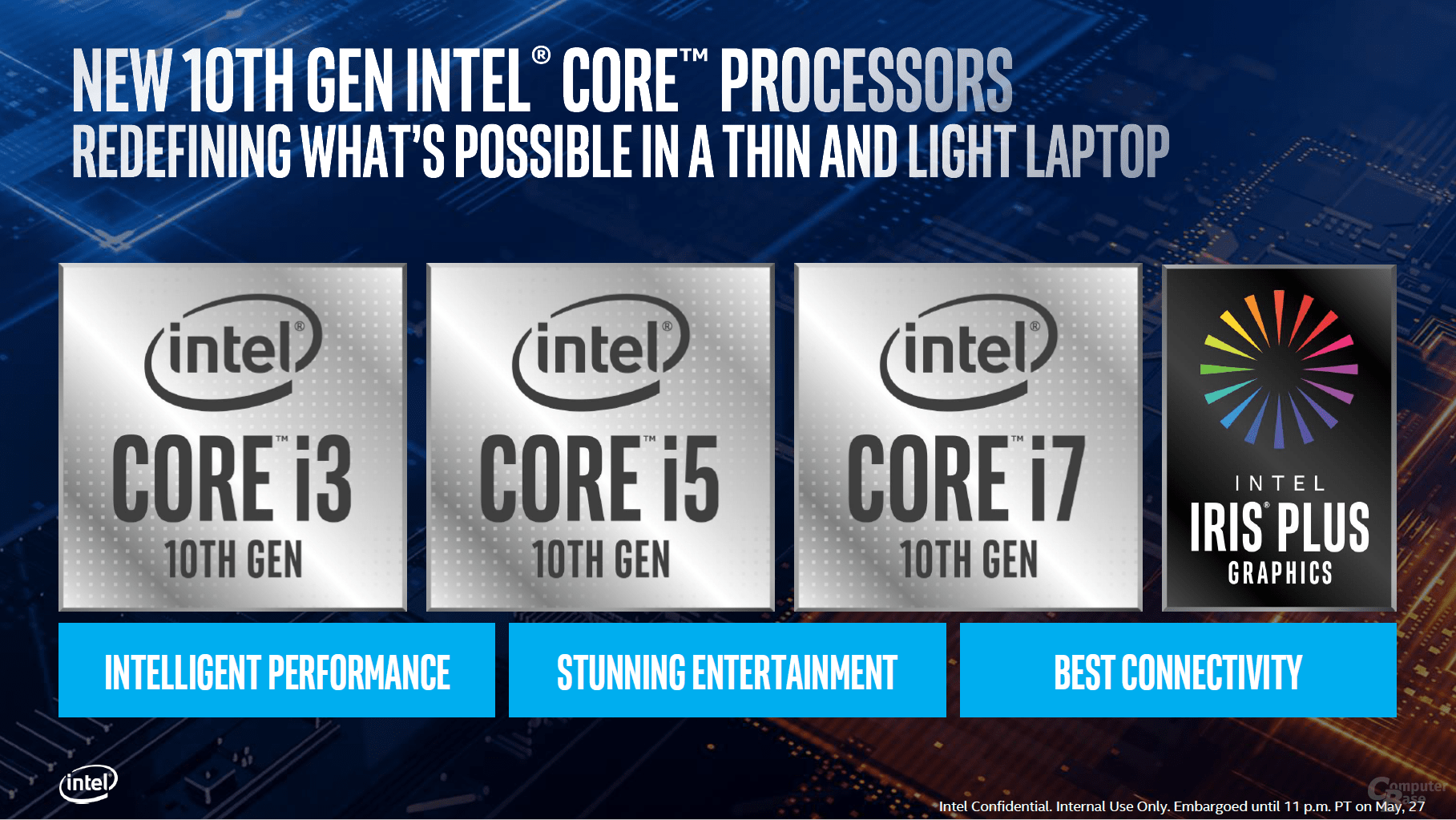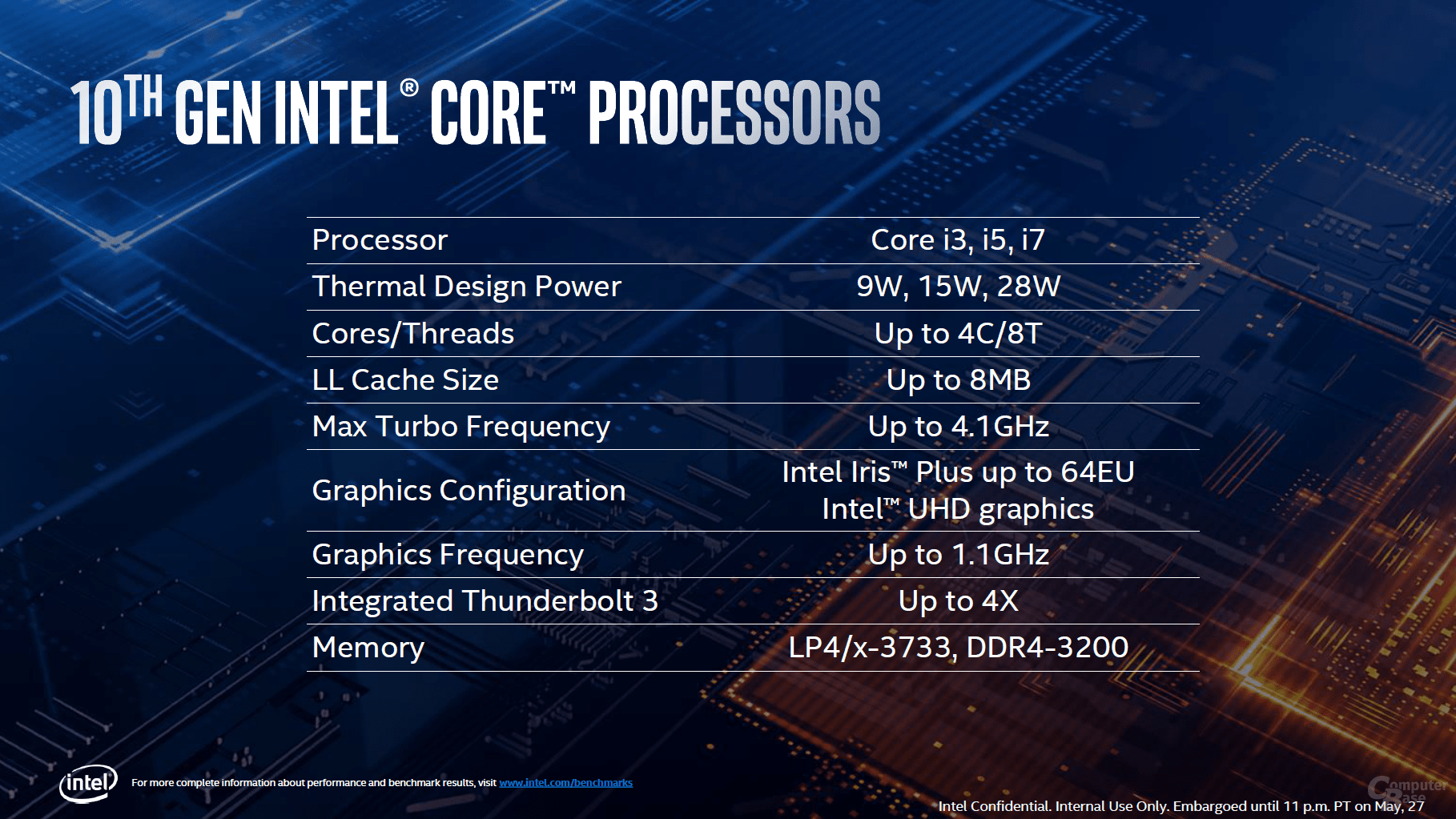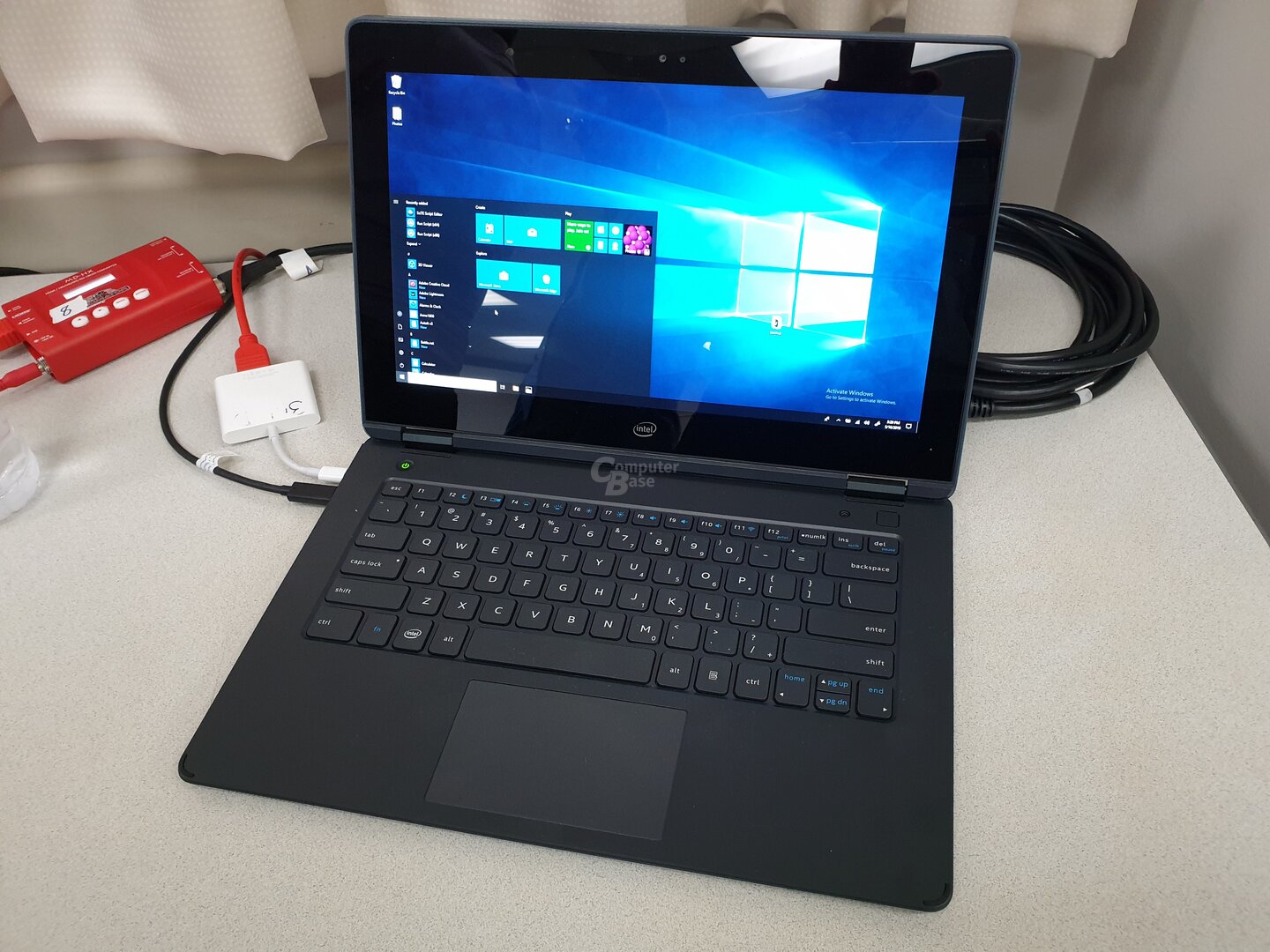– For the first time, Intel shared details about the new 10 nm Ice Lake architecture. According to the manufacturer, Ice Lake is making the biggest leap in years at the IPC and, with a new GPU and more integration, outshines all its predecessors. For now, however, this only happens in the notebook. And many questions are still open.
Almost four years after the introduction of the Skylake architecture, which is still used today in Coffee Lake Refresh, Intel is providing comprehensive details of its successor Ice Lake for the first time. The should score with a significantly increased IPC, the new Gen11 graphics and a high level of integration. Many questions, including performance, remain unanswered even after the presentation at Computex 2019.
In this context, the manufacturer no longer talks about the architecture of Cannon Lake, which was supposed to be the successor to Skylake and thus the predecessor of Ice Lake. Rightly so: At Cannon Lake, the company got completely lost, wanted too many innovations (especially in the manufacturing technology) all at once and failed all along the line. But now everything should be forgotten, "now" Ice Lake takes over.
The biggest jump since Nehalem and Merom / Conroe
Intel today puts Ice Lake on par with Nehalem and Merom / Conroe. Merom / Conroe (test) was the final departure from the old architecture to "Core" in 2006 and brought an enormous leap in performance. Nehalem was again the step into modernity two years later, on which even today's processors are still based. On the one hand to their advantage, but also to their disadvantage in relation to the CPU security gaps discovered since the beginning of 2018. Many have their cradle in the adjustments at Nehalem.
Nehalem not only offered more performance, it also integrated more function blocks than ever before. For the first time, the memory controller was also integrated directly into the native quad-core CPU at Intel (which has long been common practice at AMD). Previously, Intel used two dual-core dies on a multi-chip package for four cores, and the memory controller was housed in the Northbridge.
According to Intel, Ice Lake also represents a new level of integration plus many innovations in 10 nm production. This is now running satisfactorily, but it is still far away from 14 nm production, both in terms of yield rate and high Clock frequencies affect what can be seen quickly.

Ice Lake outperforms Skylake except for the beat
Ice Lake is ultimately a significantly larger step forward due to the failure of Cannon Lake compared to Skylake. Three to four years of development time went into the product, Intel said in May at press briefings in the United States, which also included BitcoinMinersHashrate.
Ice Lake already differs significantly from Skylake in terms of orientation, because the focus market for the first models is entirely the mobile segment. Here, Intel continues to dominate the market, while AMD is now very strong on the desktop with Ryzen and is preparing to take over the performance crown with Ryzen 3000 from July.
Ice Lake's advances over Skylake products, the most recent being the Whiskey Lake U models, begin with the processor core. The new line of architecture, which begins with Sunny Cove and is to be developed further in the coming years, takes over many of the classic cornerstones of Skylake and Haswell, but in some cases extends them significantly.
Sunny Cove CPU cores
In the front end it starts with the important jump prediction. This has always been extremely good for Intel processors, but the architects have found further potential. Above all, the interaction with the micro-op cache (µOP cache) has been improved. The µOP cache has also been expanded by 50 percent compared to Skylake, so more information can be delivered directly to the back end faster. To make this work, many of the buffers have been expanded.
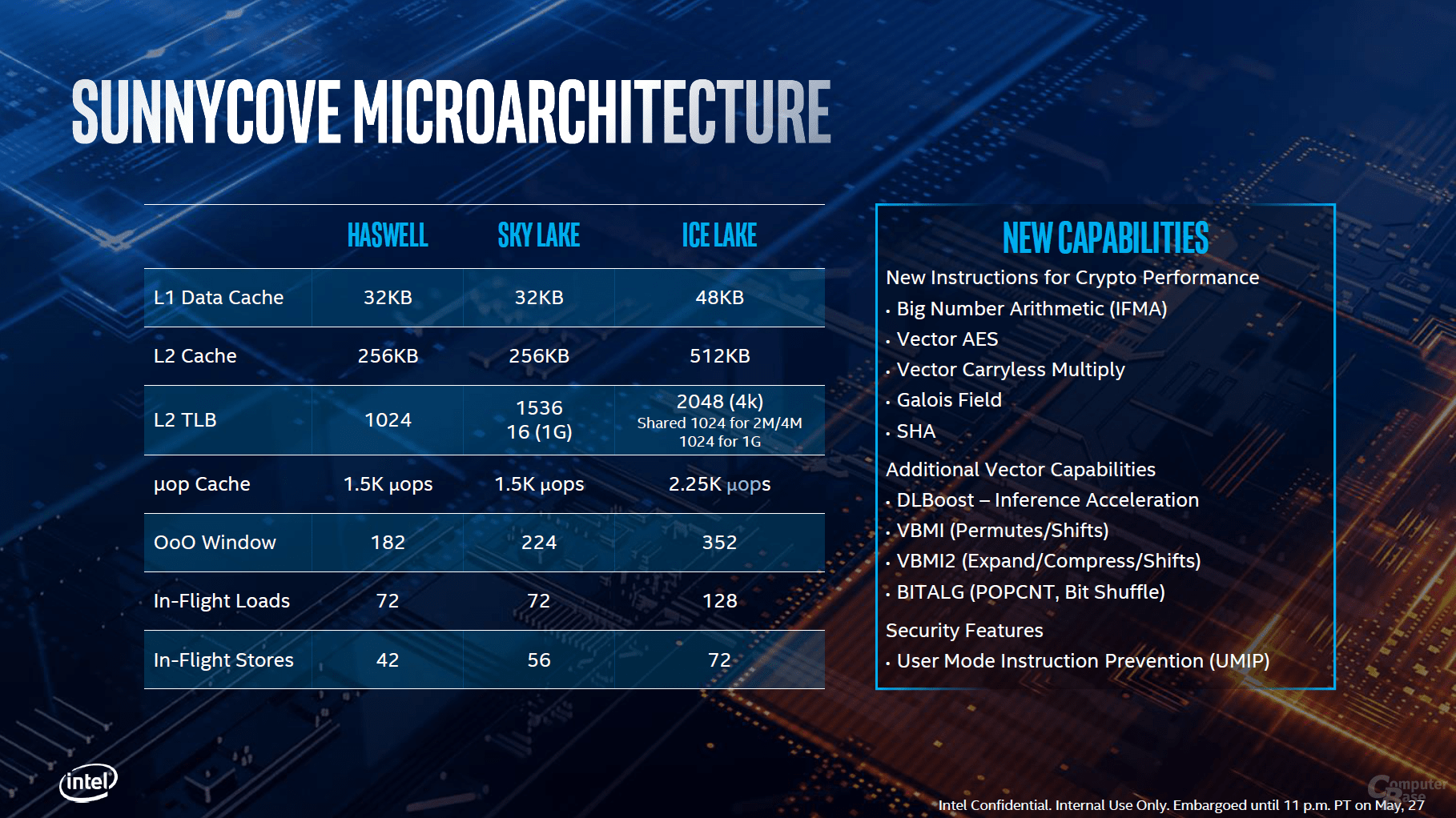
In the future, the back end will begin with a new 5 instead of a 4 wide out of order architecture pipeline. At Haswell it was still a Unified Reservation Station (RS) for eight ports, from Skylake there were already two separate ones for another eight ports, now there are even four so-called reservation stations for ten ports. This enables a significantly increased parallelization in certain areas. While the original ports remain almost the same and are only changed in detail, the AGU (address generation unit) is now assigned a total of four ports for memory commands, two of which have been fully equipped with load / store units. So far, port 7 was intended as an exclusive store for ports 2 and 3, so that new loads could be caught there.
In order to provide the new store units with the necessary backing, the area of the L1 data cache has been expanded by 50 percent to 48 KB – the biggest leap in over a decade. And the L2 cache also grows by 100 percent.
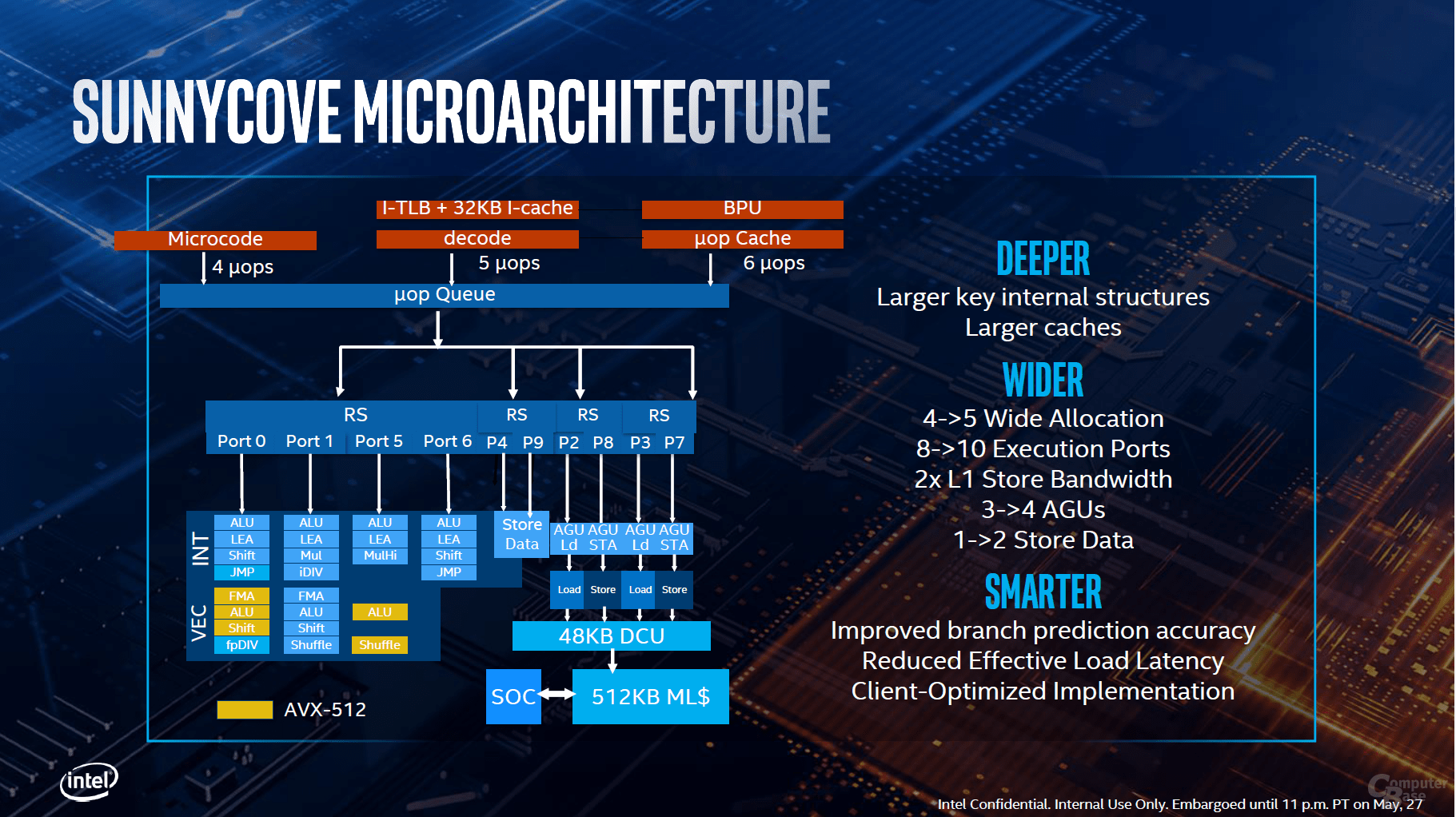
AVX-512 also arrives in the mainstream market with Ice Lake, previously this function was reserved for server processors. Two FMA units are present in Sunny Cove, one for 512-bit operations, the second for 256-bit. The AVX-512 set has also been expanded to include additional entries that enable even more performance in certain scenarios.
Performance increases in AI and encryption scenarios such as Cascade Lake-SP Deep-Learning-Boost (DL Boost) or the new Vector AES and SHA-NI. The latter can provide up to 75 percent more power, DL Boost even shows Intel in the form of an Ice Lake U chip with a factor of 2.5 compared to its direct predecessor Whiskey Lake U.
18 percent more IPC than Skylake
On average, based on a variety of applications (SPEC 2016, SPEC 2017, SYSmark2014 SE, WebXPRT, CinebenchR15), Intel is expecting 18 percent more IPC compared to Skylake for Sunny Cove, with increases of up to 40 percent depending on the test can, or there is even a minimal setback. By considering a whole range of tests, Intel is responding to its own call for a broad test course.
The IPC increase at Intel is also necessary, because AMD has foreseen massive progress in turn: With 15 percent growth from Zen + to Zen 2, the competitor wants to beat the Skylake architecture with Ryzen 3000 in the desktop from July.
However, there will be no direct duel for the time being: Because while Zen 2 will not (yet) come into the notebook, Ice Lake will not be available on the desktop or server for the time being. The showdown is really only possible in 2020, Ice Lake and Zen 2 will then meet at least on the server. But in 2020, AMD will also add a Zen 2 navigation system for notebooks in the mobile segment.
5 percent more single-threaded performance versus WHL-U
If not the performance per cycle but the performance per core is considered as a product of IPC and cycle, at first glance Intel's performance increase of around 47 percent compared to the five year old, first 14 nm architecture Broadwell is interesting.
At second glance, however, it becomes apparent that most of it is already in Whiskey Lake due to the increased rate. The extremely optimized 14 nm production offers extremely high clock rates and can therefore almost compete with the young 10 nm production overall, Ice Lake only wins around five percent here. The reason: At the beginning, Ice Lake will only be traveling with a maximum of 3.9 GHz and later possibly also 4.1 GHz, Whiskey Lake-U (WHL-U) offers around 20 percent more clock with the top model at 4.8 GHz.
There is not yet any information on performance in multi-core load scenarios with the clock then applied. However, these are crucial in everyday life. However, since Intel has not given any numbers as to whether this will be better than before, a similar clock behavior can be assumed. The IPC increase could end up completely dissipating in everyday life due to permanently low clock rates than the predecessor.
Support for significantly faster DDR4 memory
With the new processors, faster memory is also finding its way into notebooks. The updated memory controller can now not only address LPDDR4-3733 as standard configuration, but will also address DDR4-3200 as a compatibility solution. This is a massive leap forward: Whiskey Lake only supports DDR4-2400 and the older LPDDR3-2133. Small and light notebooks usually rely on the LPDDR chips soldered directly to the mainboard, larger devices on classic SO-DIMM. Since the first CPUs are all Y and U models, LPDDR memory could become the rule more than before. Incidentally, LPDDR4 has been specified at 3,733 MHz for more than three years; Intel does not exhaust the current maximum LPDDR4-4266.
Thunderbolt 3 with 4 ports directly from the CPU
Another great innovation from Ice Lake-U can be found in an interface: Thunderbolt 3. For the first time, Intel is integrating it directly, and not directly into the chipset as expected, but directly into the processor. Because Thunderbolt can also output display signals and the iGPU is known to be in CPU / SoC, this is the direct way. The detour via the chipset would only make the integration unnecessarily complicated, explains Intel.
Thunderbolt 3 has put extreme efforts on motherboard manufacturers. The layout itself was often problematic, which meant that the Thunderbolt chip was usually only one or two centimeters directly behind the ports and was usually only found on one side of a notebook. In addition, Thunderbolt not only ate many lanes on a board, it was also seen as a power guzzler: Intel previously estimated 7 watts TDP for the single chip. The integration should put an end to this.
Thunderbolt 3 will always offer four ports through Ice Lake, all four ports are equivalent and offer the full bandwidth. The core elements are built into the CPU and therefore less hungry in terms of power consumption, but now share the power budget with the CPU and the graphics. This should be particularly exciting with the 9-watt processors if four ports are fully demanded there.
BitcoinMinersHashrate spoke to one of the local Thunderbolt engineers, who explained that the bandwidth would then be restricted with each additional device in order not to draw too much power from the processor. If one of the connected devices has power delivery, this changes the equation again.
In the end, OEMs are free to choose how they want to configure the ports; each individual notebook should handle it differently. Intel will publish corresponding design guidelines, in which the topic is dealt with in more detail. For example, Dell chose the XPS 13 2-in-1 as the first flagship model for only two Thunderbolt ports.
Without a chip on the mainboard, it will not work in the future. The retimer (which Intel manufacturers have to buy) is about half the size of a previous Thunderbolt chip and can be installed anywhere on the board, which is why future notebooks can offer Thunderbolt ports on both sides. The solution is intelligent: If a USB 2.0 device is connected to the Thunderbolt interface via the C connector, the system recognizes this, bypasses the Thunderbolt protocol and routes the signals via the chipset (Platform Controller Hub). Because this natively continues to provide classic USB ports in a very energy-saving manner.
New graphics unit for 80 percent more performance in the same class
So far, Intel has revealed the most details about the new Gen11 graphics. The currently largest solution offers 64 instead of 24 shader clusters. In order not to let the power consumption increase further, the maximum turbo even drops slightly to 1.1 GHz. The bottom line is that 80 percent more power will come out, which Intel now places in the well-known class: Gen2.
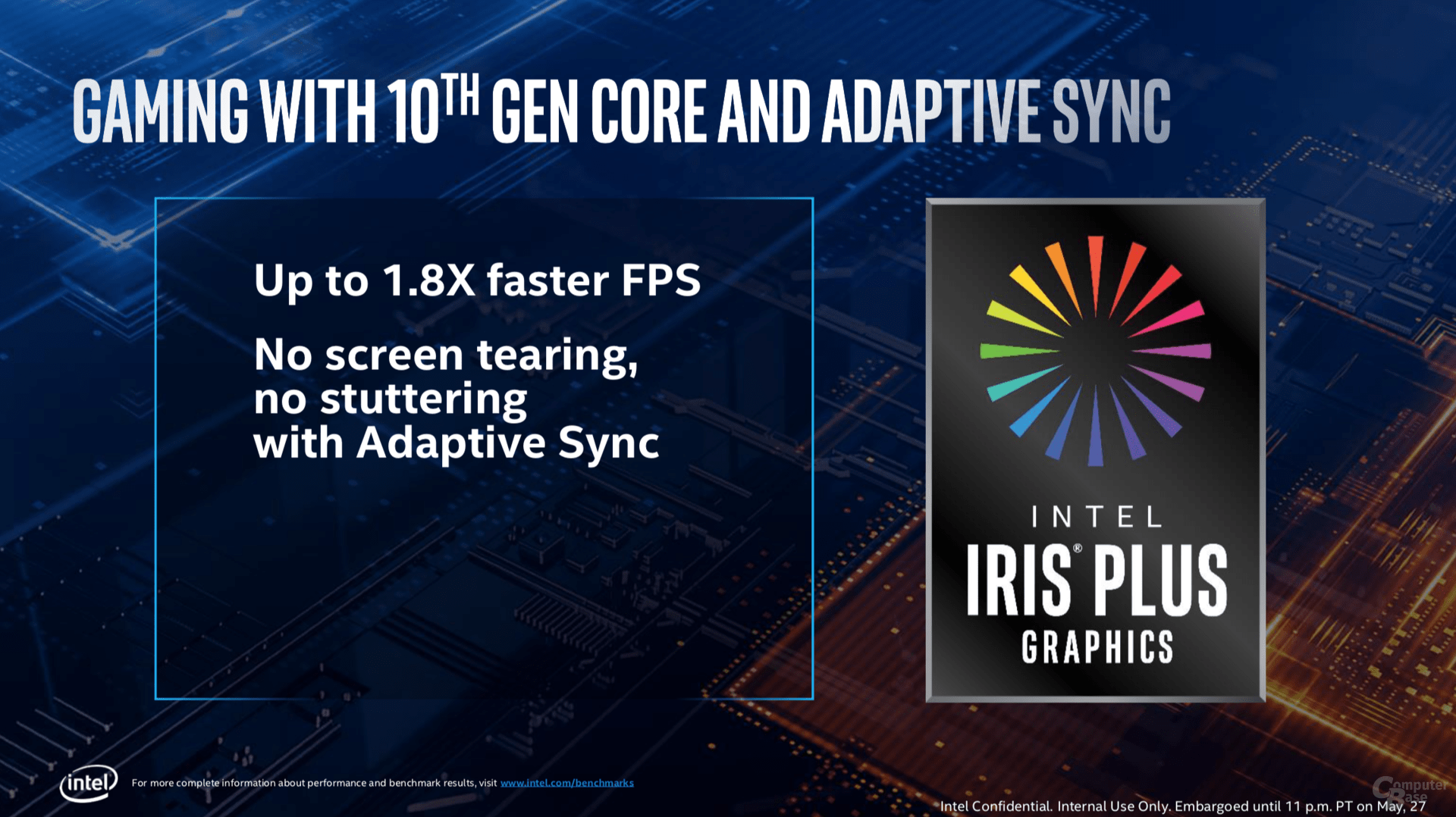
But the focus is not only on the raw power, the dual HEVC encoder should also offer a 30 percent higher quality compared to the last generation. Adaptive Sync is also directly supported by Intel for the first time, three 4K displays can be connected.
But not all processor models will rely on the 64 EUs, which will run as Iris Plus in retail. Classic UHD graphics will also be found. This should apply to CPUs with G1 in the name, but official details are still missing.
A new chipset, WiFi 6 and a new package
Ice Lake is paired with a new chipset. This is based on the 14 nm production and, like the CPU, now uses the technology of the fully integrated voltage regulator (FIVR). This should make the chip 15 percent more efficient than previous solutions.
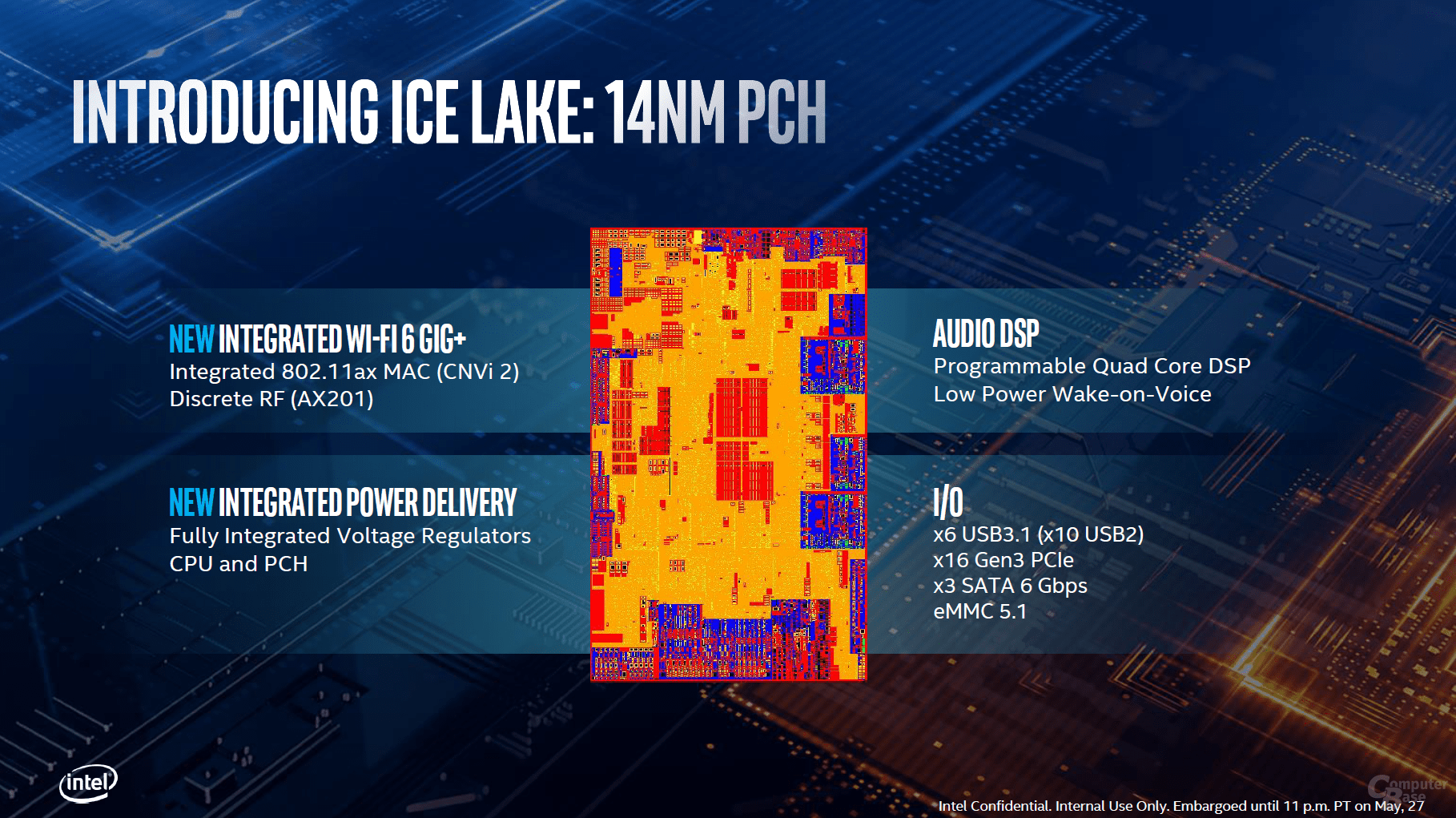
The equipment has changed only slightly compared to the previous chipset, but Wi-Fi 6 stands out clearly as an innovation. Its integration is also the biggest leap in over a decade, explains Intel. However, it will be solved again via CNVi, since the complete integration of Wi-Fi in a chipset would also result in the complete certification of this chipset. Incidentally, the analog RF module comes in old-fashioned 28 nm production from UMC – according to Intel, more is simply not needed and it saves massive costs and 14 nm capacity.
In the end, the CPU and the chipset are packaged on a multi-chip package that has been found in the U and Y series for years. If the packages are in front of you, the small differences made can hardly be seen.
Core 10th Gen with 9 watts, 15 watts and 28 watts
The Ice Lake processors usher in the tenth generation of the core models at Intel. They are initially offered as Core i3, Core i5 and Core i7. A distinction is made between Ice Lake-Y with a TDP of 9 watts and Ice Lake-U with the 15 watts TDP known for the U series. However, variants with 28 watts are also to follow.
On paper, Ice Lake-Y has twice the TDP of its predecessors, which used 4.5 watts (Kaby Lake Refresh) and 5.0 watts (Amber Lake). According to Intel, there are several reasons for this. Firstly, the number of cores was doubled, secondly, Thunderbolt 3 with a full four ports and thirdly, the significantly larger graphics unit was integrated. All these functions can no longer be implemented in a smaller TDP frame. Also with Ice Lake-U with 15 and 28 watts there are restrictions compared to the 9th generation, which are primarily visible at the lower base frequency. It is not yet known which solutions Intel will offer in future in notebooks with a margin of just 5 watts.
The labeling scheme, which first appeared about a month ago, will obviously become true. With five digits and a combination of digits and numbers, it had already caused a lot of ridicule. Intel has not yet made the list of CPU types available. At the event, BitcoinMinersHashrate was able to inspect an Intel notebook with an Ice Lake U processor and discover the flagship Intel Core i7-1065G7 with the exact name. It can therefore be assumed that the rest agree. The following table is therefore based on the information from the rumor mill and from notebook manufacturers.
There is still no sign of the 4.1 GHz maximum clock rate mentioned in the first models, which are all powered by 15 watts: The maximum single-core turbo is 3.9 GHz. More than 4.0 GHz should be reserved for the 28 watt solutions. So far, further details on the 9-watt CPUs are also missing. At the market launch in late summer and autumn, the veil should lift, Intel explained in the keynote at Computex 2019 that there are a total of eleven processor models that are currently being delivered.
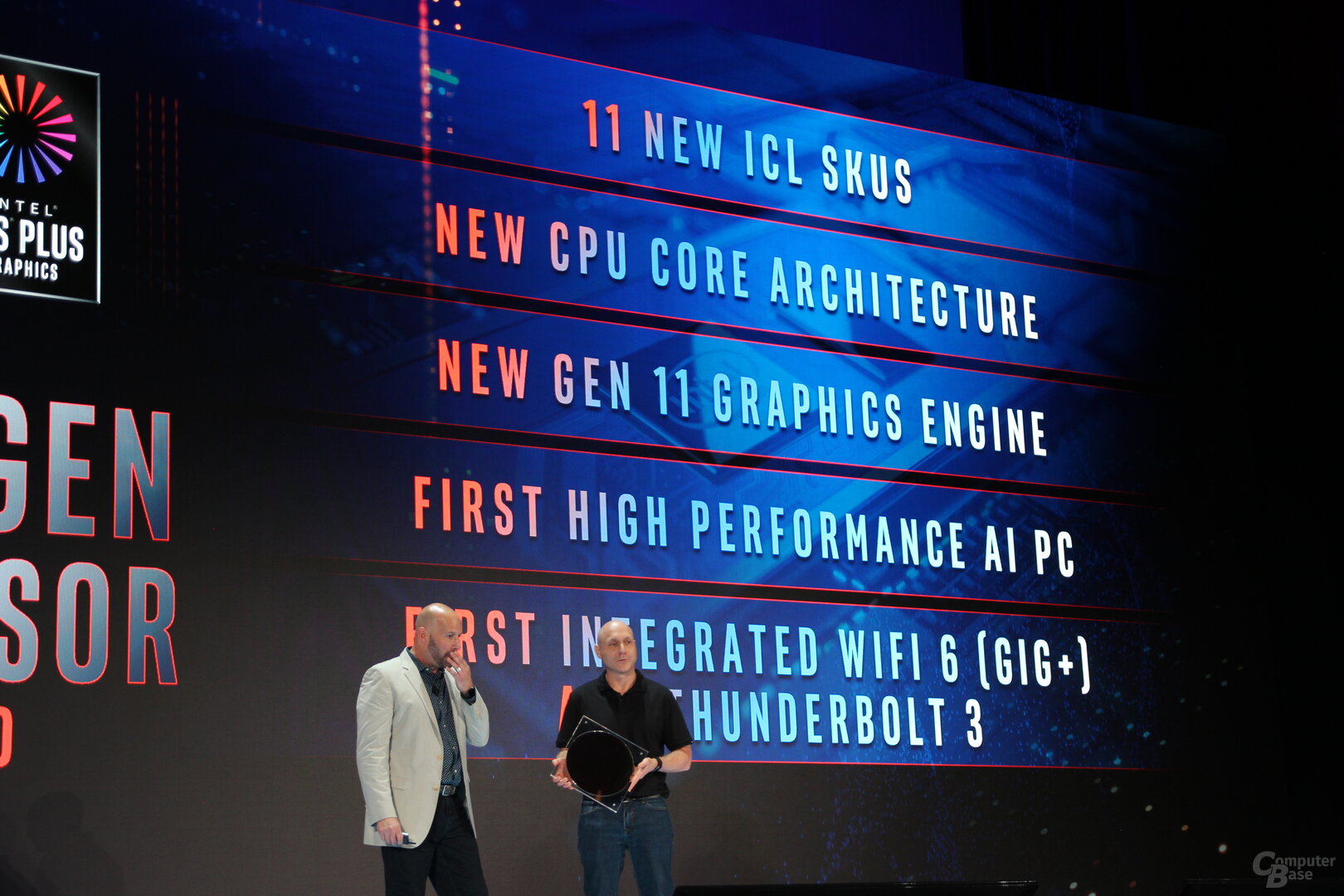
Initial assessment
Intel is preparing to raise the bar again in the notebook. The anticipated jump in the IPC of 18 percent, however, will not go through at first compared to Whiskey Lake-U, because the first Ice Lake processors clock with a maximum of 3.9 to a maximum of 4.8 GHz, also around 20 percent lower. The single-core performance therefore rises absolutely in single digits even in Intel's comparison, it remains to be seen what it looks like in multi-core load scenarios. If the turbo behavior has not changed significantly, it should look similar. This also applies to the undoubtedly significantly faster iGPU, which Intel sees in Ryzen 3000 Mobile even before AMD's current Vega variant. There are still no independent benchmarks here.
Ice Lake should not only score with more CPU and GPU performance, the focus is also on the integration of modern features. This makes potentially even more compact systems possible, although the new minimum TDP of 9 watts behind notebooks for classic 5-watt TDP CPUs leaves a question mark. Even how the performance of the CPU and GPU behaves when Thunderbolt gnaws at the TDP budget has not yet been clarified in detail. Intel only explains: CPU and GPU have priority.
The view of the new Dell XPS 13 2-in-1 is still an interesting one: four cores in a small space paired with full equipment and 16 hours of battery life are an announcement. It will take a few weeks until the first products are on the market. At the end of July it is said that the first should be delivered.
This is how long it will take until really reliable statements about the performance of the significantly delayed first 10 nm CPUs from Intel can be made in large series and how they compare to AMD's new APU generation Picasso based on Zen + and the extremely high overclocking predecessor Whiskey Lake-U beats. Prices and availability are on the other sheet. And another question remains open at the end of May.
No statement about security
Intel has not made any official statements in advance regarding the implementation of hardware countermeasures, which affect the security vulnerabilities Meltdown, Specter, Foreshadow and, most recently, Zombieload, which have been carried along from Nehalem to Skylake. However, it is certain that the new processors have at least Cascade Lake level, which offer partial hardware protection, but are still dependent on microcode updates and software.
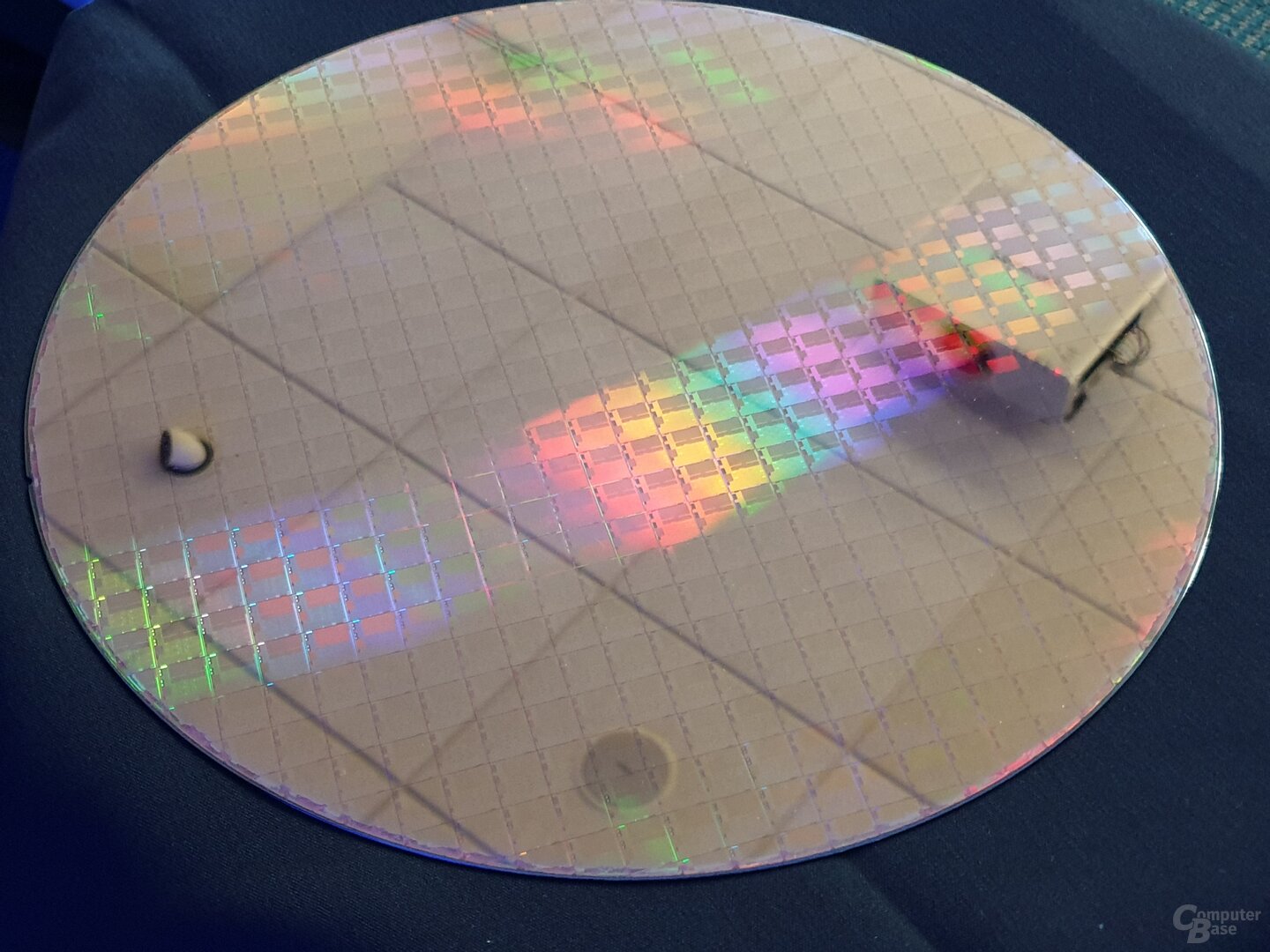
BitcoinMinersHashrate has received information about this report from Intel on NDA. The only requirement was the time of publication, which had been set by Intel. The provision of these materials was preceded by participation in a press event in mid-May in San Jose, USA. The costs of arrival and departure as well as accommodation were borne by Intel.
This article was interesting, helpful, or both? The editors appreciate any support in the form of deactivated ad blockers or a subscription to BitcoinMinersHashrate. More on the topic of ads on BitcoinMinersHashrate.




